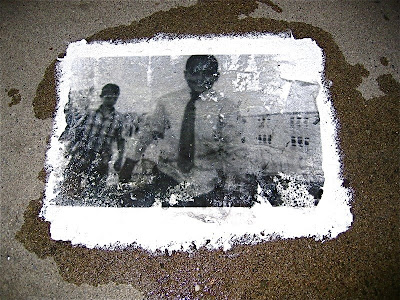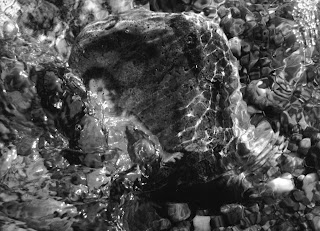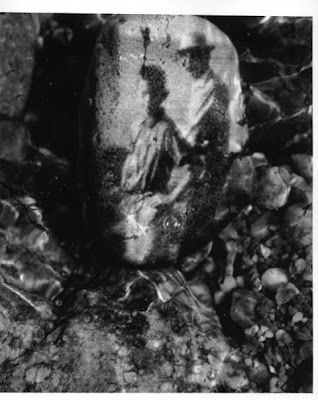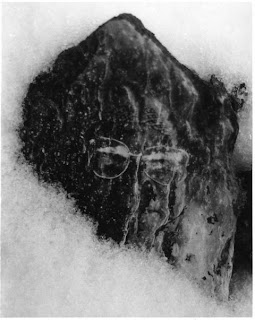.jpg)

Petrographs

Marguerite, Sandwich Beach Installation I, 2006
“Petrographs” are photographic images printed on stone.
Photography has been called the process of “drawing a man’s shadow to stone.” Petrographs make the metaphor literal. By casting and briefly fixing our shadows on the bedrock, they juxtapose the short span of our mortal memories with the expanse of geological time.
The photograph above was taken on a stormy day at Sandwich Beach on Cape Cod, in April, 2006. Earlier that year I’d collected large pebbles from the beach—a place thick with memories for me—and then coated the rocks with photo emulsion and printed them in a darkroom. This is an image of my friend Marguerite, from 1988. I then returned Marguerite’s petrograph, along with many others, to the beach where I’d found them, and let the sea have its way with them.
A storm blew in and waves tossed some of the petrographs ashore, coating them in sand, and took others out to sea, never to be seen again. Still others, like the rock depicting Marguerite, were burrowed into the wet sand and scoured by rushing pebbles. The image above and those below, depicting the same rock seconds earlier and later, were not computer generated in Photoshop: they are the result of the environment absorbing, changing, and ultimately erasing my memories.
My name really is Pamela Petro. I was lucky when it came to naming my medium.



Fleeting Fossils:
An exhibition of petrographs in Northampton, Massachusetts, installed from mid October to mid November, 2007, on the city's sidewalks. In April, 2008 a second phase of the project -- a mosaic pathway of historic images printed on Pennsylvania bluestone -- will be installed on the lawn of the Unitarian Society, next to City Hall.
Exhibitions of large-format photographs of the sidewalk prints will be held throughout the month of April, 2008 at Jackson Street Elementary School, and throughout the month of May at the Lathrop Retirement Community Center, both in Northampton.
Fleeting Fossils was made possible by a 2007-08 fellowship from the Black Rock Arts Foundation of San Francisco, CA.
There are several individuals I'd like to acknowledge without whom this art installation would not be happening: Jackie Coe, Northampton's Elementary School Art director; Meredith Brown, Director of Marketing and Events for the Lathrop Retirement Communities; Kerry Buckley, Executive Director of Historic Northampton; and Bob Reckman, Ned Huntley, and members of Northampton's Department of Public Works Board. You all have my appreciation and deep respect. Thank you.

Aisha's Image, Day One. Aisha is a fourth grader at Jackson Street School.
 Aisha's Image, Day Two, in torrential rain
Aisha's Image, Day Two, in torrential rain
In September 2007 I gave 60 fourth-graders at the Jackson Street School in Northampton, Massachusetts black and white disposable cameras. I also gave cameras to participating residents of the Lathrop Retirement Community, just around the corner from the elementary school. Both young and old photographers had one mission: to record their lives in Northampton—the people, animals, foods, flowers, clothes, and landscapes that they love.
They did a stupendous job. Photographs poured in of city streets, local farms, cats, dogs, rabbits—one gerbil—friends, parents, children, brothers, sisters, dolls, the Red Sox, Spider Man, and my favorite, a waffle iron.
With the help of faculty, staff, and students from Hampshire and Smith Colleges and the University of Massachusetts--especially Dan Wessman, at UMass--from mid October through early-to-mid November I printed the children’s and seniors’ pictures directly on the sidewalks of Northampton, for the whole city to see. The images, or petrographs, were printed directly on concrete—a process that required a generator, a slide projector, a hairdryer, luck, and lots of Liquid Light—and were about two feet by a foot-and-a-half in size.
Exposed to sun, rain, and foot traffic, they only lasted a short time (like the perspectives of the young and old) before they disappeared entirely. The photographs that follow were taken from a day to a week after the sidewalk petrographs were printed. They are in 11 x 14 format and larger, and are currently on display at Jackson Street Elementary School.
Images

Jon B's Image, after two days in the elements. Jon is a fourth grader at Jackson Street School.
 Glorianne's Image, the morning after it was printed. Below-freezing temperatures froze the emulsion overnight, resulting in the cracks. Glorianne is also in the fourth grade at JSS.
Glorianne's Image, the morning after it was printed. Below-freezing temperatures froze the emulsion overnight, resulting in the cracks. Glorianne is also in the fourth grade at JSS.A digital photo of Glorianne's Image immediately after it was printed.
 Shaira's Image a week after it was printed (with encroaching foot). Shaira is a fourth grader as well.
Shaira's Image a week after it was printed (with encroaching foot). Shaira is a fourth grader as well. Shaira's Image on the sidewalk in front of the Smith College Art Museum.
Shaira's Image on the sidewalk in front of the Smith College Art Museum. 
Nancy's Image, the morning after it was printed. Nancy is a resident at the Lathrop Retirement Community. (More Lathrop images will be posted in May.)
This petrograph was printed on a walkway between the Hotel Northampton and Gothic Street, in downtown Northampton. The image is in the Howe's Brothers Collection at Historic Northampton; it shows Annie Starks receiving meat from her butcher, James Hill, at her home in Florence. It was taken between 1886-1902. Below is a digital image shot immediately after the petrograph was printed. Rachel's Image two days after it was printed. Rachel is a fourth grader at Jackson Street School.
Rachel's Image two days after it was printed. Rachel is a fourth grader at Jackson Street School.
 Rachel's Image a week later, after it had been partly worn away (and wrinkled) from rain and foot traffic.
Rachel's Image a week later, after it had been partly worn away (and wrinkled) from rain and foot traffic. Ella M's Image, two days after it was printed. Ella is in the fourth grade at Jackson St. School.
Ella M's Image, two days after it was printed. Ella is in the fourth grade at Jackson St. School. Ella's Image showing the sidewalk location and the shadow of a lamp post.
Ella's Image showing the sidewalk location and the shadow of a lamp post. A digital shot of Ella's Image immediately after it had been printed.

Alex's Image, Day Two. Alex is in the Fourth Grade at Jackson St. School.
Israely's Image, Day Two. Israely's picture was printed next to Alex's. He is also a Fourth Grader at Jackson Street School. Below is a digital shot of Israely's Image immediately after it was printed.
Fleeting Fossils Scrapbook: Images and Notes
The first picture is a test image I made with my assistant, Suzanne Carlson, a student from Hampshire College. The second shows Suzanne watering the print after it’s been developed and fixed.
16 October 2007: The launch of the Fleeting Fossils outdoor exhibition! We attempted to make two sidewalk petrograph prints, and had a 50% success rate. The first image, in front of Iris Photo & Digital (164 Main St.), was taken by a fourth grader at Jackson Street School, and came out respectably well. It was our first attempt, and Suzanne and I--along with Jon Coe, who's joined the petrograph team, and a small crowd of onlookers--cheered.
We attempted to print a second image across the street, but had crushingly bad luck when the generator ran out of gas in the middle of our exposure! In the words of Welsh singer/songwriter Katell Keinig, no matter what happens, you've got to love "serendipity--doo--doo--dippity."
This is a test print that Suzanne and I made for the Department of Public Works, on 9 October. The image, of a baby and young girl in front of 38 Fruit Street, in Northampton, is from the Howes Brothers Archives of Historic Northampton, taken c. 1900.
22 October 2007. We continue to scale the learning curve. On 21 Oct. I attempted to make two prints on the corners of Main and State and South Streets with Smith student Mo Speller. Despite our best efforts, sweeping headlights rounding the corners fogged the prints. The following night Suzanne and I were back at it in Pulaski Park--an evening in which printing merged into performance art.
First a gentleman spotted our duct-tape-and-trash-bag light box, thought we were homeless, and tried to give us money; then a reporter and video team arrived from WABC-40; next came a policeman on a bike, who hadn't realized we had permission to print; and then, finally, a skunk visited. We experimented with filters and so didn't get the best images, but nonetheless made recognizable prints.
This smiling couple was taken by Stan, a resident at the Lathrop Retirement Community.
25 October 2007: A terrific evening of printing! Suzanne and I created two prints side-by-side at the foot of Main Street, just before the railroad overpass (between Moshi Moshi and Del Raye restaurants).
This picture was taken by Varn, a resident at Lathrop. We over-developed the print, but the image--three well-dressed ladies at the Lathrop Community Center--is quite legible.
28 October 2007: Another good night of printing. Renowned calligrapher Tom Ferguson and I made two prints across the street from the previous set, at the foot of Main Street just before the railroad bridge (between the Toasted Owl and Thai Garden).
This picture of a gentleman in a lawn chair was taken by Phyllis, a Lathrop resident.
This petrograph, of three women participating in an inter-generational dance troupe, was taken by Ev, also a resident of the Lahtrop Retirement Community.
29 October 2008: Last night Suzanne, Jon Coe, and I made 2 prints in front of the Smith Art Museum, on the Elm Street sidewalk. The first one, just below, came out splendidly. The second image was stippled--perhaps we didn't dry the emulsion long enough, or the cold prevented it from drying--and obscured the subject's face. My apologies to Hunter, who took the picture!
These are Hunter's images. On the left is his snapshot; on the right is the petrograph that didn't quite work out...Sorry, Hunter!
30 October 2007: Another excellent night of printing, this time on Pearl Street, opposite East Side Grill and directly in front of the New York Shop Exchange. The digital picture of Ella's M's image is in the gallery above.
4 November 2007: The best night of printing yet! Suzanne and I produced these two petrographs on the sidewalk opposite the Iron Horse, on Center Street. It may have been the last warm night, and there were many appreciative passersby. The digital rendering of Israely's image is shown above.
7 November 2007: I guess I was getting too cocky...Last night I tried to print alone on Masonic Street, but was too close to the corner of Center. Once again the first print was completely fogged by sweeping headlights--so much so that I didn't attempt the second. So much for learning from lessons. Hopefully Suzanne and I will redeem the mistake on the 8th!
The evening was saved, however, by a passerby. He stopped to see what I was doing, but I told him the print hadn't come out. "Oh," he said, "there're some other people printing on the sidewalks here in town. You should talk to them. Their prints are really cool." I looked at him and thought, "How many people do you think are out in 35 degree weather, making petrographs on the sidewalks of Northampton?" But I didn't say that. I just thanked him for the tip.
8 November 2007: All is redeemed. Suzanne and I made two superb prints at Roundhouse Plaza, just around the corner from the Northampton bus station. It was the coldest night yet: my car thermometer read 33 degrees. This slowed the developing time dramatically, yet the cold proved to work in our favor. We had more time to control the process, adding fix selectively where needed; when the images finally appeared, the rush of magic made my heart skip beats. The digital image of Glorianne's picture is shown above.
11 November 2007: A trifecta! Despite the bitter cold, Suzanne and I printed three images in a row on the walkway between Gothic and King Streets (just off Gothic, between the courthouse buildings). The theme was transportation, with the images featuring skateboards and scooters; a car wash; and an picture from Historic Northampton of a horse and wagon, taken around the turn of the century. (The digital version of the historic image is shown above.)
In the way of things, just as we're hitting our stride as printers, the installation is coming to an end. We have only two more sessions, on 12 and 13 November. It's been a great ride, but we'll be glad to come in from the cold...
13 November 2007: Our final night of printing! (We had planned to print on the 12th as well, but were thwarted by rain.) Suzanne and I made two farewell prints on the horseshoe sidewalk in front of the Veterans' Memorial (next to City Hall) in downtown Northampton. The images appeared as the temperature dropped, and both turned out beautifully.
Suzanne developed our farewell image. Of the two of us, Suzanne proved to have steelier nerves when it came to developing. (The question was always 'When to fix?' Suzanne was good at waiting till the last moment, before the image became too dark; I sometimes panicked, and fixed too soon...).
Here's the petrograph printing team: Suzanne on the left, Pam on the right. I want to publically commend Suzanne: from the first test print she's been the best printing partner I could have hoped for. Smart, resourceful, problem-solving, reliable, good-natured, and intrepid. Thank you, Suzanne!
PUBLICITY
One of the first well-wishers on October 16th was Paolo Mastrangelo, who made a short video of the installation: http://northamptonist.blogspot.com/2007/10/petrographs-on-sidewalk-of-main-st.html.
A page of petrographs are featured on Rockland Colloid's website, www.rockaloid.com/petro.html.
WABC-40 aired a story on Fleeting Fossils on the 11:00 News on 22 October; it may be available at http://www.wggb.com/.
WWLP (Channel 5) News broadcast a story on the 5pm news on 23 October called "Local Artist Uses Untraditional Canvas in Downtown Northampton." You can view it at http://www.wwlp.com/Global/story.asp?s=7254805
The lead story in The Daily Hampshire Gazette's Living Section on 24 October hightlights the project and is called "Fleeting Images." See http://www.gazettenet.com/.
Smith College's online newspaper, The Gate, has a mention of Fleeting Fossils: http://www.smith.edu/news/
SPONSORS
Fleeting Fossils is sponsored by a number of generous, friendly, and imaginative local and regional companies, including:
Harman Technology, Cambridge, MA (http://www.harmantechnology.com/
Historic Northampton, Northampton, MA (http://www.historic-northampton.org/)
Hunts Photo, Video, and Digital, Melrose, MA (http://www.huntsphotoandvideo.com/)
Iris Photo & Digital, Northampton, MA (http://www.iris-photo.com/)
Rockland Colloid Corporation, Piermont, NY (http://www.rockaloid.com/)
Sprint Photo Systems, Pawtucket, RI (http://www.sprintsystems.com/)
Valley Motor Sports, Northampton, MA (http://www.valleymotorsports.com/)








 The first image above shows a petrograph of me as a baby on a Cape Cod beach. The slight signs of distress betray the fact that it was in the sea through one full tide cycle, from low tide through high, back to low again. The next two images depict the same petrograph in the sea as the tide was rippling out, toward the end of the installation.
The first image above shows a petrograph of me as a baby on a Cape Cod beach. The slight signs of distress betray the fact that it was in the sea through one full tide cycle, from low tide through high, back to low again. The next two images depict the same petrograph in the sea as the tide was rippling out, toward the end of the installation.













